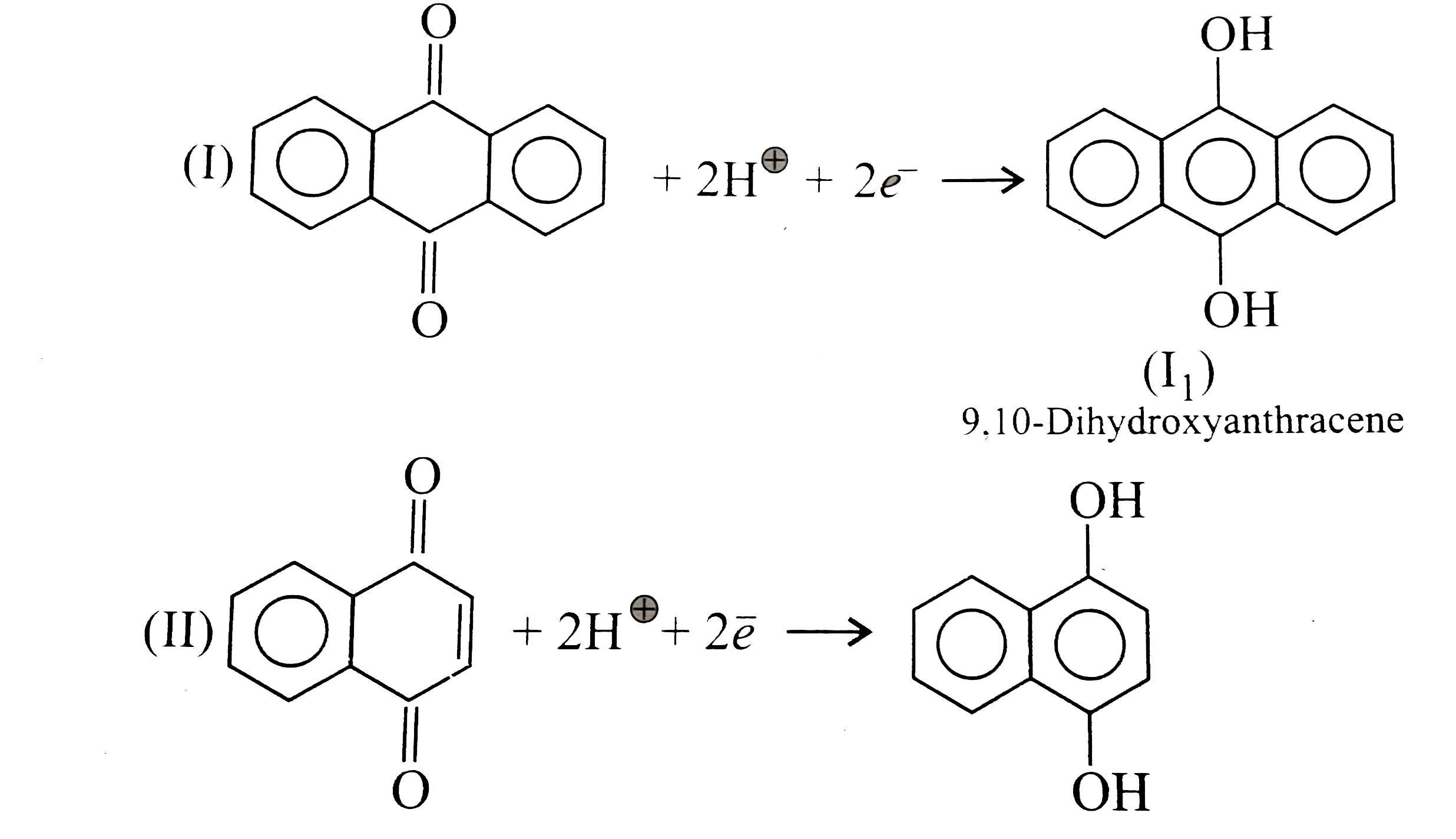Quinones are good electron acceptors, party because reduction restores aromaticity.

Give the decreasing order of of the following quinones

Decreasing order or
After reduction, products are

Reactivity order
Stability order
is more stable due to or effect of than and effect of .
More stable the product means faster the reduction of quinone to hydroquinone and therefore higher value Decreasing order of value in
Stability order
Reactivity order
is more easily reducedt to
 because it generates two aromatic rings which have more resonance energy and greater stability than the reaction of and , which would generate only one benzene ring.
because it generates two aromatic rings which have more resonance energy and greater stability than the reaction of and , which would generate only one benzene ring.
Both and on reduction give one benzene ring, but is less stable more reactive than because adjacent groups in make it less stable .

The reaction is representes as follows
Reduction potential .
Stability order
Reactivity order
Standard reduction potential

has two individual benzene rings whose combined resonance energy along with that ot two groups is more than the resonance energy of three benzene rings of reduced product .
Topper's Solved these Questions
- ELECTROCHEMISTRYBOOK - CENGAGE CHEMISTRYCHAPTER - ELECTROCHEMISTRYEXERCISE - Solved Examples(Electrolysis And Electrolytic Cells)
12 Videos
- ELECTROCHEMISTRYBOOK - CENGAGE CHEMISTRYCHAPTER - ELECTROCHEMISTRYEXERCISE - Ex 3.1 (Objective)
28 Videos
- ELECTROCHEMISTRYBOOK - CENGAGE CHEMISTRYCHAPTER - ELECTROCHEMISTRYEXERCISE - Archieves Subjective
35 Videos
- D AND F BLOCK ELEMENTSBOOK - CENGAGE CHEMISTRYCHAPTER - D AND F BLOCK ELEMENTSEXERCISE - Archives Subjective
29 Videos
- GENERAL PRINCIPLES AND PROCESS OF ISOLATION OF ELEMENTSBOOK - CENGAGE CHEMISTRYCHAPTER - GENERAL PRINCIPLES AND PROCESS OF ISOLATION OF ELEMENTSEXERCISE - Archives (Subjective)
14 Videos
Similar Questions
Knowledge Check
In a half reaction, nitrate is reduced by 6e− reduction to x as follows
7H++NO−3+6e−→2H2O+x. The 'x' in the reaction isANOBNH2NH2CNH3DNH2OHThe number of electrons required to balanced the following equation-
NO−3+4H++e−→2H2O+NO is -A5B4C3D2The standard potential of the reaction
H2O+e−→(12)H2+OH− at 298 K by using kw(H2O)=10−14, is:AE∘=RTFlnKwBE∘=RTFln [pH2]1/2[OH−]CE∘=RTFln [pH2]1/2[H+]DE∘=−RTFlnKW
In the reaction
C2O−24+MnO−4+H+→Mn+2+CO2 the reductants is -
View SolutionHydrogen peroxide is a powerful oxidising agent.
It is an electron acceptor in acidic and alkaline mediums .
H2O2+2H++2e−→H2O (in acidic medium )
H2O2+2e−→2OH− (in alkaline medium)
It can also act as reducing agent towards powerful oxidising agents . H2O2→2H++O2+2e
In alkaline medium , however , its reducing nature is more effective . H2O2+2OH−→2H2O+O2+2e−
In which of the following reactions , H2O2 acts as an oxidising agent ?
View SolutionHydrogen peroxide is a powerful oxidising agent.
It is an electron acceptor in acidic and alkaline mediums .
H2O2+2H++2e−→H2O (in acidic medium )
H2O2+2e−→2OH− (in alkaline medium)
It can also act as reducing agent towards powerful oxidising agents . H2O2→2H++O2+2e
In alkaline medium , however , its reducing nature is more effective . H2O2+2OH−→2H2O+O2+2e−
In which of the following reactions , H2O2 acts a reducing agent ?
View SolutionIn the reaction
C2O2−4+MnO−4+H+→Mn2++CO2+H2O
the reductant is
View SolutionHydrogen peroxide is a powerful oxidising agent.
It is an electron acceptor in acidic and alkaline mediums .
H2O2+2H++2e−→H2O (in acidic medium )
H2O2+2e−→2OH− (in alkaline medium)
It can also act as reducing agent towards powerful oxidising agents . H2O2→2H++O2+2e
In alkaline medium , however , its reducing nature is more effective . H2O2+2OH−→2H2O+O2+2e−
In the reaction ,
H2O2+O3→H2O+2O2,H2O2 acts as :
View Solution
